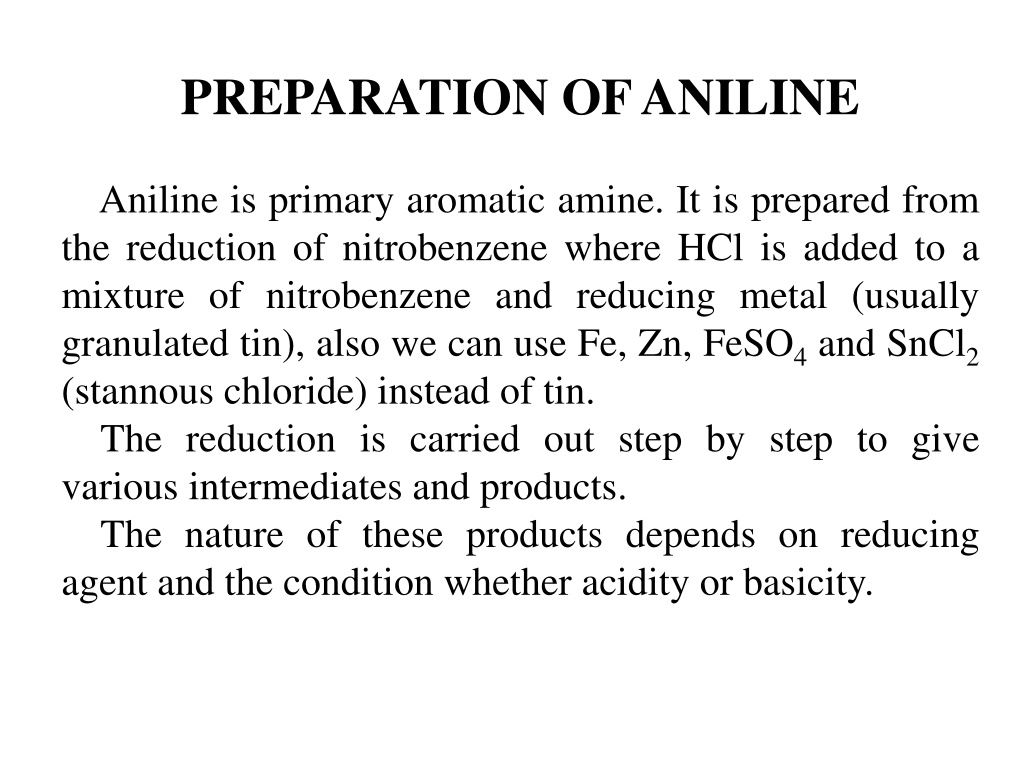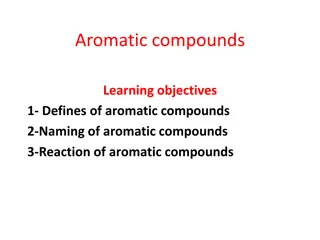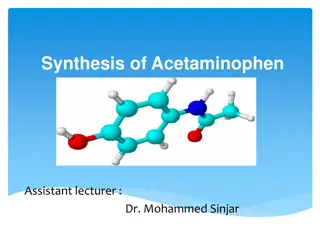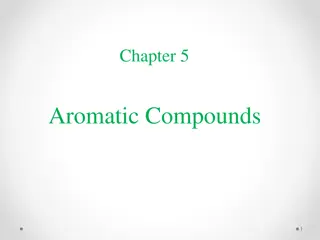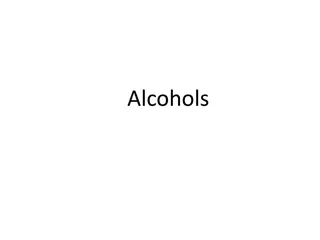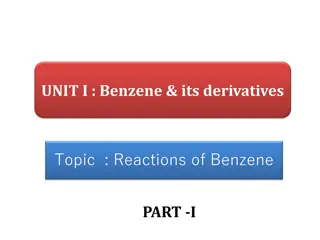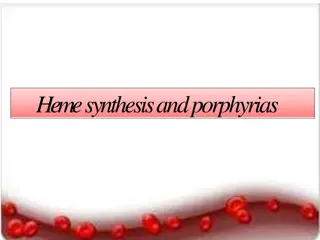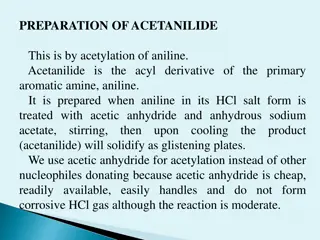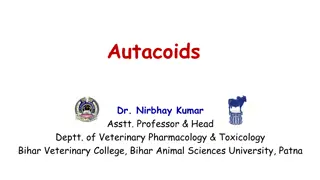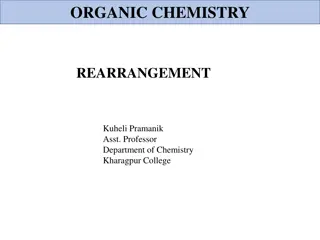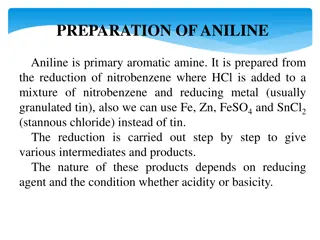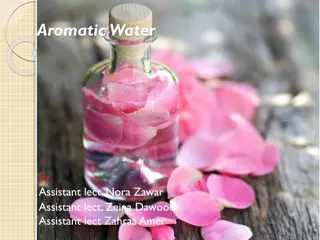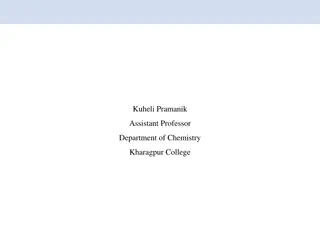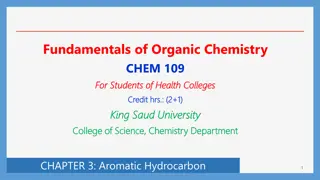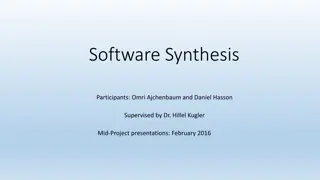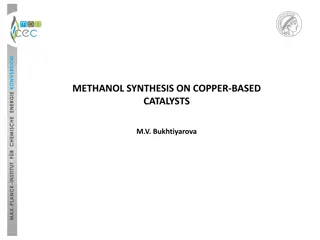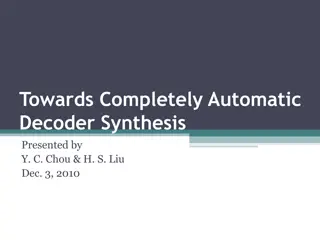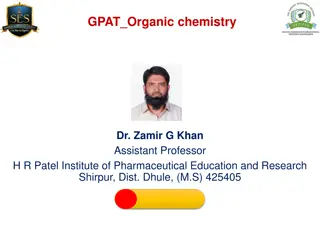Preparation of Aniline: Aromatic Amine Synthesis from Nitrobenzene
Aniline, a primary aromatic amine, is synthesized from nitrobenzene through a stepwise reduction process using various reducing agents. The addition of HCl to nitrobenzene with a reducing metal like tin yields aniline chloride. Subsequent treatment with NaOH liberates the free amine through steam distillation. Purification involves separating unreacted nitrobenzene and complex salts. Basic and acidic conditions result in different by-products affecting yield. Aniline properties include slight water solubility, necessitating salting out for recovery.
Download Presentation

Please find below an Image/Link to download the presentation.
The content on the website is provided AS IS for your information and personal use only. It may not be sold, licensed, or shared on other websites without obtaining consent from the author. Download presentation by click this link. If you encounter any issues during the download, it is possible that the publisher has removed the file from their server.
E N D
Presentation Transcript
PREPARATION OF ANILINE Aniline is primary aromatic amine. It is prepared from the reduction of nitrobenzene where HCl is added to a mixture of nitrobenzene and reducing metal (usually granulated tin), also we can use Fe, Zn, FeSO4 and SnCl2 (stannous chloride) instead of tin. The reduction is carried out step by step to give various intermediates and products. The nature of these products depends on reducing agent and the condition whether acidity or basicity.
In case of using acidic solution: Sn + 2HCl SnCl2 +2H+ SnCl2 + 2HCl SnCl4 + 2H+ 3FeSO4 + 3HCl Fe2(SO4)3 + FeCl3 + 3H+ The aniline is obtained as salt form (aniline chloride), the free amine is liberated by the addition of base (usually NaOH) and then steam distilled from the reaction mixture. The crude amine (aniline) is generally contaminated with some unreacted nitrobenzene from which it can be separated by taking advantage of the basic property of amines.
The amine is soluble in the dil. Mineral acid. Nitrobenzene is not soluble because it is neutral, and aniline is base and therefore we add HCl to separate aniline from nitrobenzene. 2C6H5NO2 + 3Sn + 12HCl 2C6H5NH2 + 3SnCl4 + 4H2O Nitrobenzene Tin Sn + 4HCl SnCl4 + 4H+ C6H5NO2 + 6H+ C6H5NH2 + 2H2O The 6H+ are required for the reduction of one nitro group, and the reduction of nitrobenzene is going through 3 steps as follows: NO2 2H+ 2H+ Aniline st. chloride NO NHOH NH2 2H+ Nitrobenzene N-nitrosobenzene N-phenylhydroxyl benzene Aniline
After preparation of aniline, it is present as a white-yellow colored complex called (C6H5NH2)HCl.SnCl4. Aniline will be separated from this complex by the addition of NaOH. Sometimes, double salt will be formed during the reaction (C6H5NH2)2SnCl4. This double salt may decompose by the addition of excess amount of NaOH, thus, both aniline chlorostannate and the double salt will breakdown to aniline by NaOH. The addition of NaOH will converts the tin into water soluble stannite and stannate salt. SnCl4 + 2NaOH Na2SnO2 (stannate) or Na2SnO3 (stannite) Also, insoluble impurities derived from the tin may be formed so aniline could be purified using steam distillation, then dry and distill again. aniline chlorostannate
In case of using basic condition: SnCl2 + NaOH Sn(OH)2 + NaOH (excess) Na2Sn(OH)4 Na2Sn(OH)4 N N Azobenzene NH2 H N H N 2 Hydrozobenzene O Azoxibenzene N N These are undesirable by-products which reduce the amount of yield.
Properties of aniline: Aniline is appreciably (slightly) soluble in water, it has solubility of 3 %, so it must be salted out by saturating the distillate with NaCl salt after preparation and steam distillation. Boiling point of aniline is 184 C, it is colorless liquid when freshly distilled but becomes colored upon standing particularly when exposed to the sunlight due to atmospheric oxidation. The color may usually be removed by distillation from little zinc. Aniline is oxidized by dichromate giving p-benzoquinone. NH2 NH O = Cr2O7 O O
.. H H N H H H H H H + + H H + N N N N - - - Chemical test: Aniline with bromine gives white-yellow precipitate of 2,4,6-tribromoaniline. This is very fast reaction. Also this test is used to know whether the distillate contains aniline or not. NH2 NH2 Br Br + 3Br2 + 3HBr Br 2,4,6-tribromoaniline
Steam distillation for purification of aniline: Steam distillation is a process of separation and purification of organic compounds. Essentially this process of operation consists of volatilizing the substance by passing steam into a mixture of the compound with water provided that the organic compound has certain properties: 1. Appreciable vapor pressure about 5-10 mmHg at 100 C, so it will be distilled with steam. 2. It Should be immiscible with water. 3. It Should be volatile with steam.
Steam distillation takes place at a temperature below the boiling point of each component of the mixture (i.e. H2O and aniline) which is 98.4 C. So this process is useful to purify many organic compounds of high BP with low-temperature distillation. Steam distillation is useful in the following cases: 1. When the substance undergoes decomposition when distilled alone at atmospheric pressure. 2. In the separation of desired organic compounds from: A. Non volatile tarry substances which are formed as byproduct in many reactions. B. From aqueous mixtures containing water-soluble inorganic salts. C. In cases where other means of separation might lead to difficulties, e.g. direct extraction of aniline with ether lead to fixed emulsion formation due to presence of alkaline media and the oily nature of aniline.
Procedure: 1. Put 5 ml nitrobenzene in flask. 2. Add granulated tin. 3. Add 25 ml HCl gradually, insert thermometer, swirl well to promote reaction in 3-phase reaction mixture. Let warm until temperature reaches 55-60 C. Cool in ice bath to prevent rising above 60 C. 4. Continue swirling and cooling for 15 min. 5. Remove and wash the thermometer. 6. After steam distillation, add NaOH then add NaCl, pour the mixture in separatory funnel. 7. Extract with benzene. Take upper layer, pass through anhydrous sod. sulfate, then separate benzene from aniline by steam distillation.
